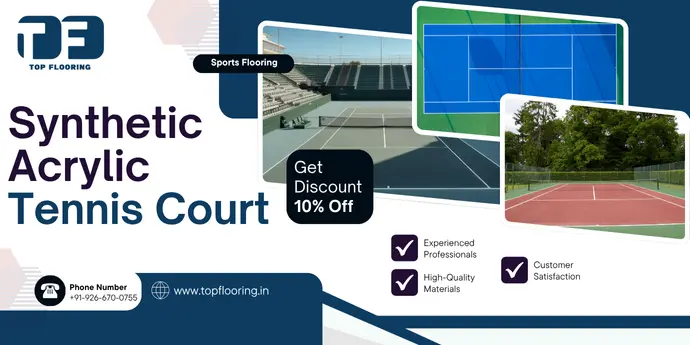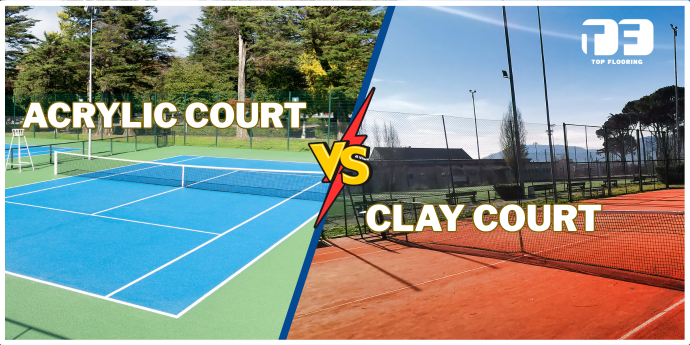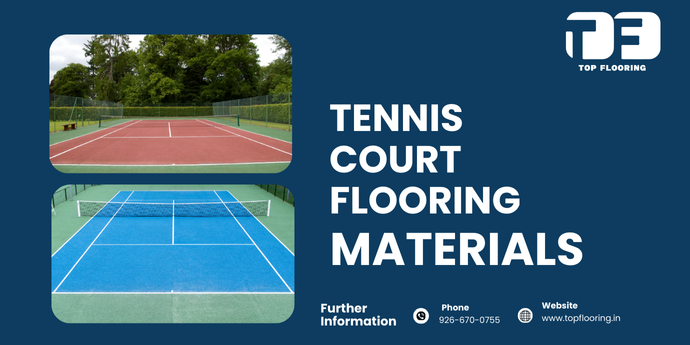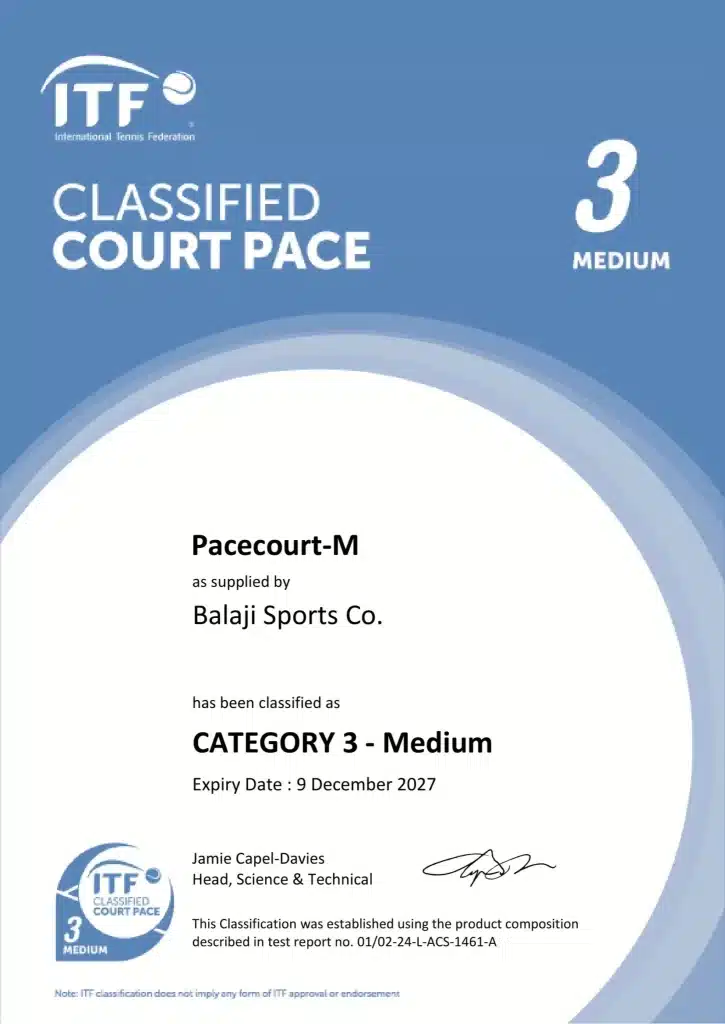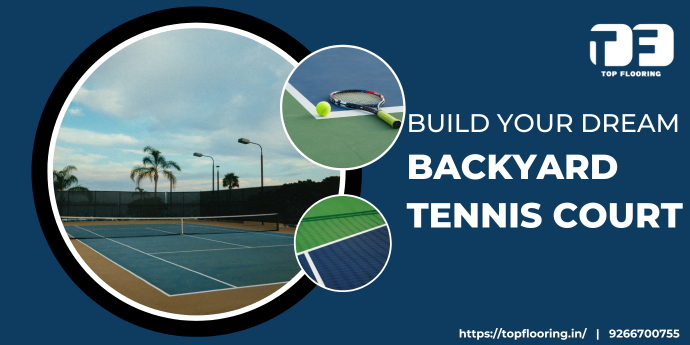
Owning a tennis court in your backyard is not just about benefits, it is about creating a space that mixes fitness, recreation, and long-term property value. When people search “how much does it cost to build a tennis court in the backyard” or “tennis court installation near me,” they’re often surprised to learn that the answer depends on more than just surface material or paint. A court is a highly engineered project involving tennis court base construction, surface selection, fencing, lighting, and ongoing maintenance. Understanding all of these factors is crucial before you take the step into building your own tennis court in the backyard.
How to Make a Home Tennis Court: From Site Planning to Installation
Building a tennis court begins long before the first layer of paint is applied. The most important decision is choosing the right location and direction. A regular-size tennis court measures 78 feet long and 36 feet wide for doubles play, but once you point out for safety and space for movement, the recommended total area increases to at least 60 × 120 feet. Without this additional approval, rallies feel cramped, and players risk colliding with fences or walls.
Professional tennis court installation companies will also make sure that your court is lined up properly. Courts are ideally built along a north–south axis, which reduces sun glare during morning and afternoon games. Ignoring this detail could leave players struggling against the sun every time they serve, reducing playability and enjoyment. These are the kinds of fine details that separate DIY attempts from professional projects handled by an experienced tennis court company.
Another early step is to make sure proper tennis court base construction. The ground must be leveled and compacted, and engineers typically design a slight slope about 1% to allow rainwater to drain off naturally. Without this, water can pool on the surface, causing cracks, slippery conditions, and faster decline of even the best tennis hard court material.
Understanding the Cost to Build a Tennis Court in Backyard
When you search “how much to build a tennis court in backyard” or “price to build a tennis court in backyard,” you’ll find a wide range. That’s because the cost to build a tennis court in the backyard depends on a variety of parts that together create the final playfield.
1. Tennis Court Base Construction Costs
The base is the foundation of the entire court, and it is also where much of the cost lies. Asphalt tennis court construction is a common option because it is affordable and relatively quick to install. Asphalt courts play well at first, but they can develop cracks over time, especially in areas with extreme heat or cold. Concrete, on the other hand, especially post-tensioned concrete, costs more in advance but provides unmatched durability. Post-tensioning uses steel cables within the slab to stop cracking, making sure the court stays smooth for years. Choosing the right base affects not just the average cost of building a tennis court, but also how often you will need tennis court renovations later.
2. Tennis Court Surface Material Choices
The surface system controls how the court feels underfoot, how the ball bounces, and how much maintenance is required. Acrylic tennis court construction is the most popular choice for homeowners looking for a professional look and feel. Acrylic layers, mixed with cushioning and sand infill, create a consistent bounce, UV resistance, and slip control. On the other hand, modular tiles offer quick installation and are easier to maintain since damaged sections can be replaced one by one. Clay and grass are niche options clay is easier on joints but demands daily grooming, while grass provides a traditional fast game but comes with high maintenance requirements. Each tennis court surface material comes with its own price tag, so the decision directly influences how much it costs to build a tennis court.
3. Accessories and Add-On Features
Beyond the surface itself, additional features make a tennis court truly functional. Fencing is necessary, as it keeps balls within the court and makes sure safety for nearby property. High-quality chain link fencing with windscreens is a common choice. Lighting is another factor; LED lights allow for evening matches and extend playtime. Landscaping around the court, watcher seating, and storage space for tools also add to the average cost of building a tennis court. While these extras might seem optional, skipping them can lower playability and make the court feel incomplete.
How Much Does a Tennis Court Cost to Build in the Backyard?
For most homeowners, the big question is: how much does a tennis court cost to build? The answer lies in breaking down costs by stage.
- Base Preparation: Typically, the largest single cost. Asphalt is cheaper but may require repairs sooner, while concrete increases in advance investment but lowers maintenance. Both control the long-term cost of ownership.
- Surface Installation: Whether you choose tennis hard court surface material, modular tiles, or clay, the price costs are widely. Acrylic systems sit comfortably in the middle of the budget range but provide excellent performance, which is why they choose backyard installations.
- Fencing and Lighting: These are often underestimated. Without fencing, balls always escape, and without lighting, your play is limited to daylight hours. These features raise the price to build a tennis court but add notable usability.
- Finishing Touches: Nets, posts, center straps, windscreens, and even color customization are final costs. Many tennis court construction companies also recommend adding blended lines for pickleball or mini-tennis, which turns one investment into a multi-sport facility.
By the way, the average cost of building a tennis court varies depending on whether you want a simple, functional playfield or a luxury sports complex in your backyard.
Choosing Best Tennis Court Surface Material: What Works for Backyards?
- Acrylic Tennis Court Construction is often considered the most practical choice for private homeowners. The surface mixed durability with customization of different colors, cushioning options, and pace ratings allow players to copy professional courts like those used at the US Open. Tennis court resurfacing materials for acrylic systems are also widely available, making maintenance straightforward.
- Asphalt Tennis Court Construction with a simple acrylic court is another cost-effective option. Asphalt courts feel good underfoot and offer excellent ball bounce. However, since asphalt is prone to cracking, resurfacing may be needed more often. Still, many homeowners prefer it because the cost investment is lower than concrete.
- Hard Court Tennis Surface Systems using post-tensioned concrete are more expensive but nearly permanent. They provide a strong foundation for tennis hard court material, ensuring the court can handle heavy play without systemic damage.
- Clay and Grass Courts are less common in backyards but worth mentioning. Clay creates a slower game and is appraised by older players or those who enjoy long rallies. Grass courts, while reputable, are rarely chosen for private installations due to high maintenance costs.

Why Choose Top Flooring for Your Backyard Tennis Court Construction?
When searching “tennis court installation near me” or comparing different tennis court construction companies, it’s easy to get lost in technical details and cost guesses. But one name that stands out in India’s sports structure market is Top Flooring. Here’s why:
1. Expertise in Synthetic Acrylic Systems
Top Flooring specializes in acrylic tennis court construction, using certified materials that deliver consistent bounce, strong grip, and long-term durability. Unlike common contractors who treat a court like any other piece of concrete, Top Flooring engineers the full system from tennis court base construction to the final acrylic layers to make sure the court performs to international standards.
2. Quality Surface Materials Built for Indian Climate
India’s climate is harsh on outdoor sports courts, with blazing summers, heavy monsoons, and high UV exposure. Top Flooring uses tennis hard court surface material that is UV-resistant, weather-tolerant, and designed to last longer with minimal maintenance. That means fewer resurfacing cycles and lower lifetime costs compared to other providers.
3. Nationwide Network and Trusted Experience
With projects completed across schools, housing societies, sports academies, and private estates, Top Flooring has become a tennis court company trusted nationwide. Their team doesn’t just build courts, they provide consultation, design support, and aftercare. Whether you need a tennis court in the backyard or a multi-sport facility, their experience makes sure the surface is smooth.
4. Complete Solutions
Another reason homeowners and institutions choose Top Flooring is versatility. The same skill extends to pickleball courts, basketball courts, volleyball courts, walking tracks, and multi-sport surfaces. This makes Top Flooring an ideal partner for families or communities that want more than just tennis—transforming one investment into multiple opportunities for sport and recreation.
5. Transparent Pricing and Long-Term Value
Top Flooring stands out by offering clear cost breakdowns, explaining exactly what goes into the average cost of building a tennis court from tennis court resurfacing materials to fencing and lighting. This transparency makes sure homeowners know exactly what they’re paying for, with no surprises later.
Tennis Court Resurfacing and Renovations
Even the strongest foundation will eventually show signs of wear and tear. A tennis court, like any outdoor structure, is constantly exposed to environmental stress. The hot summer sun can cause fading and minor cracking, while heavy rains may lead to water pooling and weakening. Add to that the impact of regular play foot traffic, sliding, and ball strikes and it’s easy to see why every court needs maintenance after a few years. This is where tennis court resurfacing materials play a strong role in extending the life of your investment.
Resurfacing typically begins with an inspection. Tennis court contractors check for surface irregularities, hairline cracks and faded colour. Once the issues are identified, the tennis court resurfacing process is started. First applying a resurfacer to smooth out cracks, then adding cushion coats to restore comfort underfoot. And finally sealing everything with acrylic color paint with clear line markings. This layered approach not only saves the tennis court’s appearance but also restores the pace and bounce of the game to professional standards.
Sometimes, however, the problem lies deeper. If the base itself is compromised for example, due to drainage failure, widespread cracking, or improper slope then full tennis court renovations are required. Renovation may involve rebuilding of the base, reinforcing or upgrading the surface for proper drainage, and installing new fencing or lighting systems. In many cases, homeowners use this opportunity to upgrade their courts from asphalt tennis court construction to acrylic tennis court construction. Since acrylic systems offer long lasting and lower maintenance surface over time.
When comparing tennis court costs, resurfacing is significantly more affordable than building a new tennis court. On average, resurfacing a tennis court can extend the tennis court surface life to 7–10 years. While tennis court full reconstruction is only necessary once the base is beyond repair. For homeowners evaluating the average cost of building a tennis court versus resurfacing. The latter often represents the smarter financial choice providing a like-new playing experience without the expense of starting from scratch.
Backyard Tennis Court Trends in 2025
As we move into 2025, backyard tennis courts are no longer just functional spaces, they are becoming design statements. Homeowners are moving away from traditional green courts and embracing vibrant, modern color schemes. Dual-tone surfaces are a leading trend, with combinations like blue-and-green or red-and-grey, similar to clay aesthetics but with the durability of acrylic. These bold choices not only improve visibility during play but also enhance the overall appeal of the backyard.
Another growing trend is sustainability. With climate concerns on the rise, many families are requesting eco-friendly tennis court resurfacing materials. These coatings are designed to reduce heat buildup, improve UV resistance, and lower the environmental impact of resurfacing. Some newer systems even incorporate recycled content in the cushion layers, making courts both high-performance and eco-conscious.
Practicaly is also shaping design. Families who want to maximize their investment for multi-sport courts. Instead of giving space solely to tennis, homeowners are asking tennis court installation companies to add blended lines for sports like pickleball, futsal, or basketball. These companies make sure that the cost to build a tennis court in the backyard delivers more value. Turning a single tennis surface into a multi-purpose play zone for all ages.
Finally, technology is influencing backyard courts. LED smart lighting with energy-saving features is replacing traditional lamps, making evening matches more affordable and eco-friendly. Some premium projects even incorporate shock-absorbing surfaces that reduce stress on players’ joints. Altogether, these 2025 trends show that backyard tennis courts are evolving beyond mere playfields. They are becoming lifestyle hubs, combining sport, design, and sustainability in one space.
Conclusion
So how much does it cost to build a tennis court? The answer is layered just like the court itself. It depends on the tennis court company you choose. The type of hard court surface material and whether you add fencing and lighting. Whether you are asking “how much to put a tennis court in the backyard” or “how much to build a tennis court”. The key is planning and professional tennis court installation. Working with experienced tennis court builders and knowing the true cost of a tennis court will turn your backyard into a pro level court. It’s more than just a game, it’s a lifestyle, a health investment and a feature that adds value to your property for years to come.
Frequently Asked Questions
Yes, you can build a tennis court in your backyard if you have enough space (at least 60 ft × 120 ft for a full court) and proper ground conditions.
To build a backyard tennis court, prepare a solid base (concrete or asphalt), install proper drainage, apply a multi-layer sports surface like acrylic, and finish with line markings and fencing.
Installing a backyard tennis court costs depending on the surface type, site preparation, and additional features like fencing or lighting.
For a grass court, level the ground, install drainage, use high-quality turf grass, and maintain it with regular mowing, watering, and rolling to keep the surface playable.
A clay tennis court requires a compacted base, layers of crushed stone and brick dust, proper drainage, and regular maintenance like watering, rolling, and brushing to keep the surface firm.

